If you’ve travelled across Australia in summer, it’s almost guaranteed that the beautifully blooming bottlebrush has caught your eye. These incredible evergreen, attractive shrubs and trees are most recognised by their bottlebrush looking flowers, which are a rich source for local nectar feeders.
Remarkable and easily recognisable, the bottlebrush is a great option for growers as it’s almost impossible to kill and incredibly hardy, even in salt-laden soils.
So, if you’re considering adding the bottlebrush to your yard, here is some insight on everything you need to know to grow, cultivate and care for this incredible floral species.
More...
What is a Bottlebrush?

The genus Callistemon or bottlebrush encompasses a range of blooming shrubs and smaller trees. Belonging to the Myrtaceae family, bottlebrushes are closely related to other Aussie favourites like melaleuca plants, eucalyptus plants and the lilly pilly.
Discovered by the renowned botanist Sir Joseph Banks, the Callistemon genus includes over 40 different species and many hybridised sub-cultivars.
This ornamental landscaping plant produces green, sometimes green-grey foliage and large, cylindrical flower spikes, which bloom with radiance throughout the summer season.
Depending on the variety, cultivars bloom in bright red, crimson, yellow, pink, cream and white.
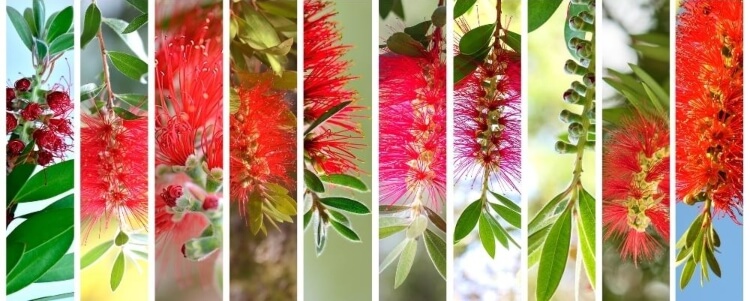
Popular Bottlebrush Varieties
It’s easy to get overwhelmed when considering which kind of Callistemon to grow, as there really are so many options to choose from. Many of the varieties have a similar blooming habit or colour and still offer a certain sense of individuality.
Here are a few of our favourites:
Popular Bottlebrush Varieties
It’s easy to get overwhelmed when considering which kind of Callistemon to grow, as there really are so many options to choose from. Many of the varieties have a similar blooming habit or colour and still offer a certain sense of individuality.
Here are a few of our favourites:
Crimson Bottlebrush (Callistemon citrinus)
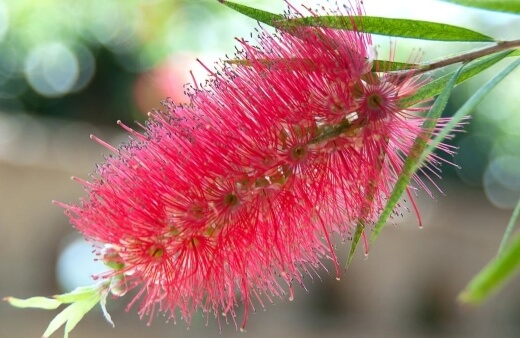
Also known as the crimson bottlebrush or lemon bottlebrush. With show-piece red flowers, it’s known as the king of the bottlebrush family. With a wide-arching canopy, the citrinus is a very popular choice.
Cultivar: Callistemon 'Pink Champagne'
Callistemon citrinus | Growing + Care Guide Australia
Albany Bottlebrush (Callistemon glaucus)

The glaucus species offers a wonderfully dense growth, perfect as a screening plant. Also known as the Albany bottlebrush, it’s an incredibly hardy, suited for a range of climates and soils. Most importantly, however, it will require full sun to bloom.


Get Your Free Guide:
Master Growing Australian Natives eBook
A Must Have Complete Guide for Every Australian Garden
Get Your Free Guide:
Master Growing Australian Natives eBook
A Must Have Complete Guide for Every Australian Garden
Prickly Bottlebrush (Callistemon brachyandrus)
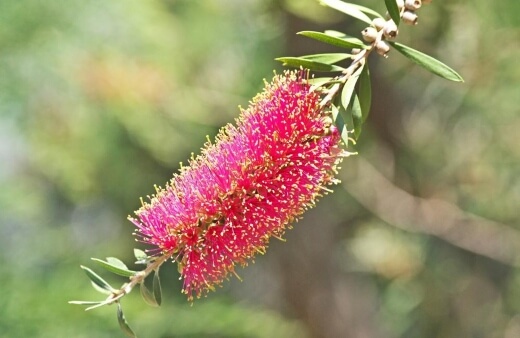
Also named the prickly bottlebrush, the brachyandrus species grows curious yellow antlers that protrude out of the red flower. Especially suited to the East Coast of Australia, this cultivar is incredibly adaptable in overly wet soils and humid conditions. Pruning is an essential part of this plant care.
Lesser Bottlebrush (Callistemon phoeniceus)
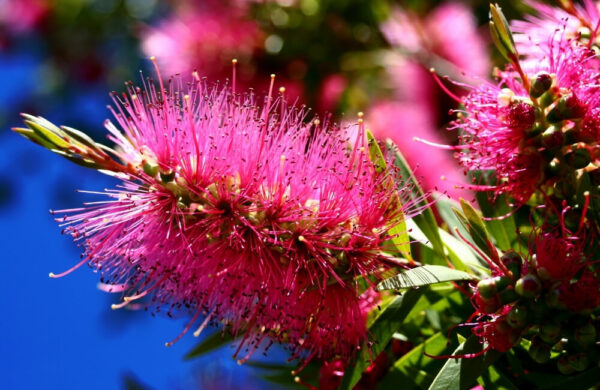
Pretty in pink, the phoeniceus is a bright and beautiful variety of the bottlebrush species. Also known as the Scarlet bottlebrush, fiery bottlebrush or lesser bottlebrush.
This is a smaller growing shrub and fairs particularly well in colder regions.
Callistemon phoeniceus | Growing + Care Guide Australia
Weeping Bottlebrush (Callistemon viminalis)
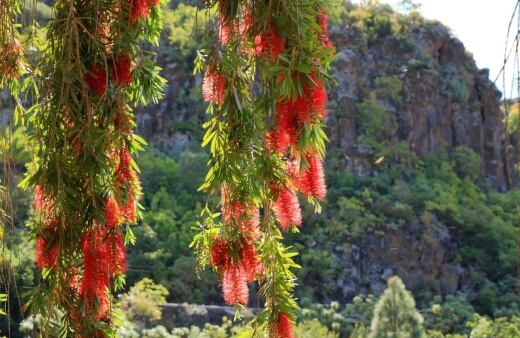
The Callistemon viminalis or weeping bottlebrush is one of the fastest-growing bottlebrush varieties. It’s a large grower, often reaching as much as 5 meters tall.
Kingaroy Bottlebrush (Callistemon formosus)
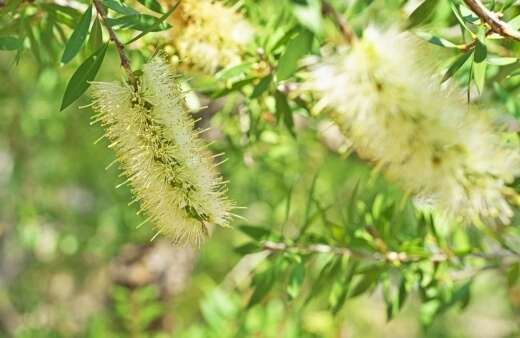
Perfect for more tropical areas, the formosus or Kingaroy bottlebrush is a fabulous, weeping variety with wonderful lemon coloured blooms.
Alpine Bottlebrush (Callistemon pityoides)

Source: Resources.austplants.com.au
Ideal for more compact spaces, the alpine bottlebrush is another yellow-bloomer with a very hardy growth habit.
Callistemon ‘Great Balls of Fire’
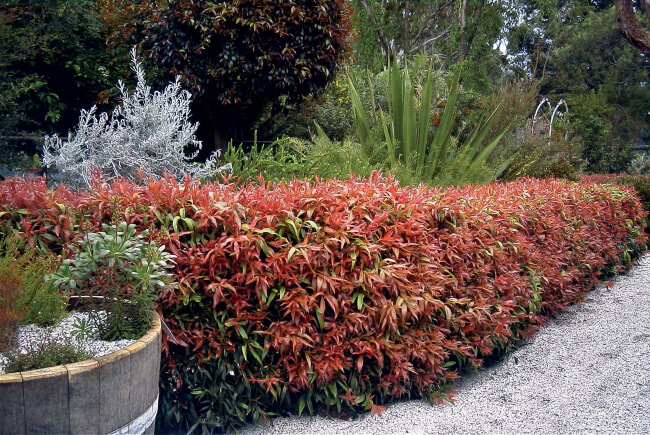
Source: Plants Management Australia
Being one of the most celebrated and colourful Callistemon cultivars, ‘Great Balls of Fire’ was propagated from Callistemon salignus and features intense pink to red new growth and a wonderfully dense and spreading habit.
It will thrive in warmer frost-free gardens and requires a sunny position in well-draining soil.
This shrub is ideal for use as a low-growing yet impactful hedge but can also be used for topiary projects or as a garden feature. It will typically reach 1 to 2 metres tall and wide.
Callistemon ‘Great Balls of Fire’ | Growing + Care Guide Australia
Crimson Bottlebrush (Callistemon citrinus)Also known as the crimson bottlebrush or lemon bottlebrush. With show-piece red flowers, it’s known as the king of the bottlebrush family. With a wide-arching canopy, the citrinus is a very popular choice. Cultivar: Callistemon 'Pink Champagne' |  |
|---|---|
Albany Bottlebrush (Callistemon glaucus)The glaucus species offers a wonderfully dense growth, perfect as a screening plant. Also known as the Albany bottlebrush, it’s an incredibly hardy, suited for a range of climates and soils. Most importantly, however, it will require full sun to bloom. |  |
Prickly Bottlebrush (Callistemon brachyandrus)Also named the prickly bottlebrush, the brachyandrus species grows curious yellow antlers that protrude out of the red flower. Especially suited to the East Coast of Australia, this species is incredibly adaptable in overly wet soils and humid conditions. Pruning is an essential part of this plant care. |  |
Lesser Bottlebrush (Callistemon phoeniceus)Pretty in pink, the phoeniceus is a bright and beautiful variety of the bottlebrush species. Also known as the Scarlet bottlebrush, fiery bottlebrush or lesser bottlebrush. This is a smaller growing shrub and fairs particularly well in colder regions. |  |
Weeping Bottlebrush (Callistemon viminalis)The Callistemon viminalis or weeping bottlebrush is one of the fastest-growing bottlebrush varieties. It’s a large grower, often reaching as much as 5 meters tall. |  |
Kingaroy Bottlebrush (Callistemon formosus)Perfect for more tropical areas, the formosus or Kingaroy bottlebrush is a fabulous, weeping variety with wonderful lemon coloured blooms. |  |
Alpine Bottlebrush (Callistemon pityoides)Ideal for more compact spaces, the alpine bottlebrush is another yellow-bloomer with a very hardy growth habit. |  Source: Resources.austplants.com.au |
Callistemon ‘Great Balls of Fire’Being one of the most celebrated and colourful Callistemon cultivars, ‘Great Balls of Fire’ was propagated from Callistemon salignus and features intense pink to red new growth and a wonderfully dense and spreading habit. It will thrive in warmer frost-free gardens and requires a sunny position in well-draining soil. This shrub is ideal for use as a low-growing yet impactful hedge but can also be used for topiary projects or as a garden feature. It will typically reach 1 to 2 metres tall and wide. Callistemon ‘Great Balls of Fire’ | Growing + Care Guide Australia |  Source: Plants Management Australia |
How to Grow Bottlebrush
Callistemon plants are known to be fairly easy to establish and even easier to maintain. As these are known to be hardy plants, they generally tend to thrive even in not so optimal conditions.
The most important growth and Callistemon care factors include the climate, sun, water and soil.
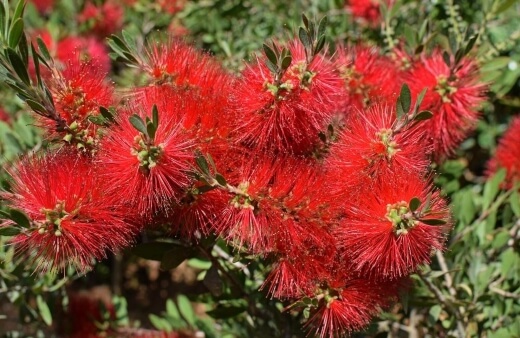
Ideal Conditions for Planting Bottlebrush
Growing Climate
The bottlebrush will grow quite happily in most climates, especially those in Australia. Depending on which variety you’re growing, extreme cold conditions are not always suitable. Ideally, you’ll want to grow your bottlebrush in a temperate climate that receives regular summer rains.
The best-known regions for bottlebrush growth include the tropical north or temperate south of Australia. It can tolerate wet conditions, but it is also somewhat drought tolerant, making it a versatile addition to flower gardens as well as a good choice for xeriscaping.
Planting Location
It’s not new news that flowering plants need a decent level of sunshine to bloom. Bottlebrush plants can grow in both full-sun and semi-shaded conditions. However, the more sun it receives, the more likely it is to bloom vigorously.
Water Bottlebrush
Younger and establishing plants will require regular moisture and water. As such, younger plants should be watered almost weekly, in the absence of rain. Once established, however, it becomes incredibly drought-tolerant and can take a few weeks without needing water.
Mulching at the base of the stem is a great way to help the soil retain moisture during particularly hot and dry spells.
Best Soil to Use
When it comes to soil, the bottlebrush is not particularly picky. However, ideally, you’ll want to have a rich, peat soil mixture. For soils that are particularly poor, it is recommended to improve soil with some compost before planting.
It is also incredibly tolerant of salty soils, so it can grow fairly easily in coastal regions. Besides these features, your Callistemon should grow fairly happily and won’t require much more of your attention.
Depending on where you are growing your bottlebrush, in a pot or as part of a hedge, annual pruning can be done to control shape. Here is our review on the best garden secateurs for the job.
Propagating Bottlebrush Plants
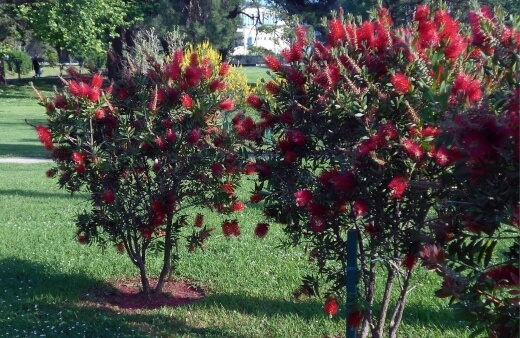
Bottlebrush plants can be propagated by means of seeds and cuttings. Semi-hardwood cuttings can be taken in mid to late summer. Cuttings should be 4 to 8 centimetres in length and include a few leaves at the end of the cuttings. The common planting method for cuttings can be followed.
After flowering, bottlebrush plants also produce a wealth of seed pods. These pods can be taken and stored until the seeds are released. Be sure to keep your seed pods in a warm, dry place for a few weeks.
Once released, seeds can be sewn into a rich seeding mix during the spring and summer.
Planting Bottlebrush
When planting your bottlebrush into your garden, be sure to pick a semi-sheltered area that receives plenty of sunlight. Dig a hole that is twice the size of the root ball, tousle the roots lose, place into the hole and backfill.
It is recommended to create a smaller ring around the base of the stem, which will help the soil retain moisture. It is possible to grow your bottlebrush in a pot, especially the smaller and dwarf varieties.
When growing in a pot, it’s essential to pick the right spot and provide your plant with a rich yet well-draining potting mix. Tousle the roots lose before planting and pressing the soil down to remove air pockets.
Mulching with sugar cane or wood chips is also advised when growing in a pot.
Potential Bottlebrush Pest & Disease Problems
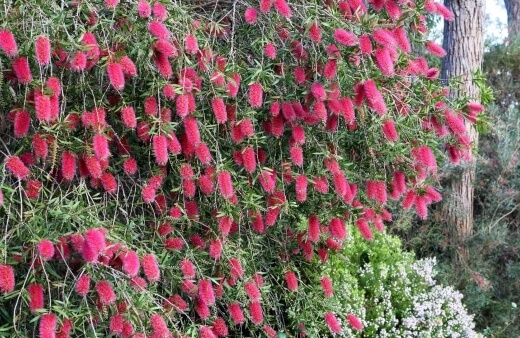
Bottlebrush plants are not often plagued or troubled by pests or infections. Sometimes, when conditions are sub-optimal for a longer period of time, it is possible for your bottlebrush to develop mould or be plagued by scale insects.
These can be easily treated with a horticultural spray.
The other issue, which has been raised by gardeners, is the threat of the Callistemon Sawfly Larvae, which invade and feed on the leaves of the bottlebrush.
For smaller invasions, it can generally be treated by a rigorous prune of all the affected foliage. For larger infestations, a caterpillar killer can be used to treat your plant.
Bottlebrush Frequently Asked Questions
Is the Bottlebrush an Australia Native?
The Callistemon is one of the most popular Aussie natives. In fact, it’s one of the hardiest endemic species that you can grow.
Is the Bottlebrush plant Poisonous?
Unfortunately, the leaves and seeds of the bottlebrush can be poisonous when ingested. As such, it’s absolutely essential not to ingest any parts of this plant and to use gloves when working with areas that may release sap.
In some instances, the ingestion of bottlebrushes can be fatal both for humans and livestock.
Can You Grow Bottlebrush as a Hedge?
Many of the lower growing cultivars, like the crimson and glaucus, are great options for flowering hedges. They are somewhat slower growing in comparison to other cultivars, and have dense foliage which provides a screening effect.
Be sure to have the best hedge trimmer handy by reading our review and buying guide.
Do Bottle Brush Trees have Invasive Roots?
The roots are slower-growing and are not considered to be invasive. As such, you can safely grow your bottlebrush along flower beds, walkways or walls.
Why is My Bottlebrush Dropping Leaves?
Browned, dried out and crumbled leaves are a sign that your bottlebrush could be in distress. This is usually caused by an extreme lack of water. Take care to monitor the level of soil moisture.
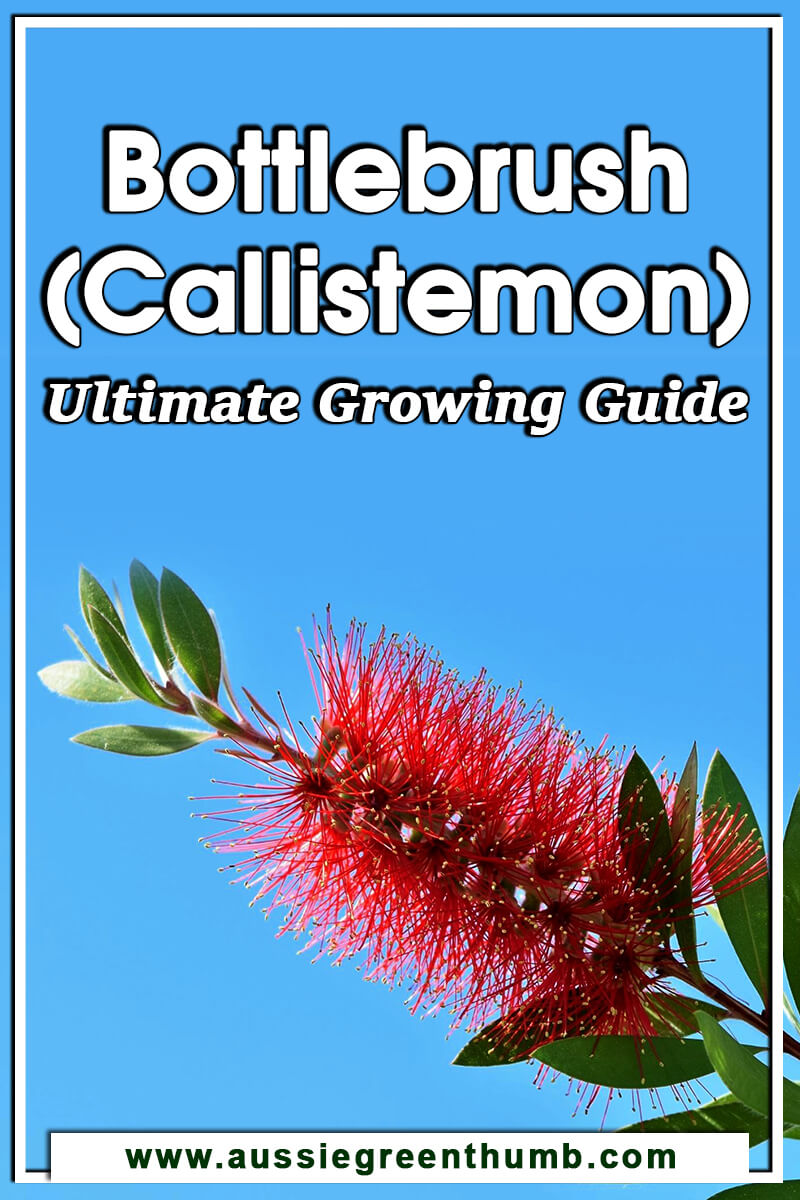
Start Growing Bottlebrush in Your Backyard today!
This endemic species offers an incredible range of bloom options, which you can mix and match as you choose. Plus, you’ll be able to enjoy all the additional garden visitors such as bees, butterflies and nectar-feeding birds almost year-round!
Whether you want a blooming garden plant, or a problem-free plant you can leave to grow in your garden – the bottlebrush or Callistemon is a perfect choice.
Published on November 24, 2021 by Gary Clarke
Last Updated on January 19, 2025





Gary Clarke,
I planted Callistemons in droves from the late 1960-90s.We are moving out in mid-November .I am trying to find the name of a red cultivar which was one of our favourites ..It is about 2-3m high with spreading branches radiating out about 3-5m from the main butt .i have the old plant,a cutting from it [6year old ],and three cuttings2/3months old .. 'can take photos and forward them .I have forgotten it's name .Could your offer advice on this matter,please ?.
Keith Beasley ,Logan Reserve,Qld
Hi Keith,
Many of the most popular varieties of Callistemon are red-flowered, but by far the best loved in Australia is C. citrinus ‘Splendens’ (which grows particularly well in Queensland, so could well be your cultivar).
If you can send pictures, I’d be happy to take a look and offer more detailed advice. If you’ve got photos of them in flower that would be even better, but there are some distinct leaf forms and tones that might be useful too.
Best regards,
Gary Clarke